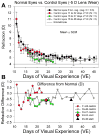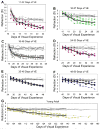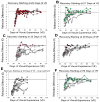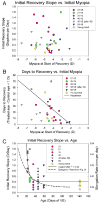The effect of age on compensation for a negative lens and recovery from lens-induced myopia in tree shrews (Tupaia glis belangeri)
- PMID: 20045711
- PMCID: PMC2885837
- DOI: 10.1016/j.visres.2009.12.014
The effect of age on compensation for a negative lens and recovery from lens-induced myopia in tree shrews (Tupaia glis belangeri)
Abstract
We examined in tree shrews the effect of age on the development of, and recovery from, myopia induced with a negative lens. Starting at 11, 16, 24, 35 or 48days after natural eye-opening (days of visual experience [VE]), juvenile tree shrews (n=5 per group) wore a monocular -5D lens for 11days. A long-term lens-wear group (n=6) began treatment at 16days of VE and wore the lens for 30days. A young adult group (n=5) began to wear a -5D lens between 93 and 107days of VE (mean+/-SD, 100+/-6days of VE) and wore the lens for 29-54days (mean+/-SD, 41.8+/-9.8days). The recovery phase in all groups was started by discontinuing -5D lens wear. Contralateral control eyes in the three youngest groups were compared with a group of age-matched normal eyes and showed a small (<1D), transient myopic shift. The amount of myopia that developed during lens wear was measured as the difference between the treated and control eye refractions. After 11days of lens wear, the induced myopia was similar for the four younger groups (near full compensation: 11days, -5.1+/-0.4D; 16days, -4.7+/-0.3D; 24days, -4.9+/-0.4D; 35days, -4.0+/-0.02) and slightly less in the oldest juvenile group (48days, -3.3+/-0.5D). The young adult animals developed -4.8+/-0.3D of myopia after a longer lens-wear period. The rate of compensation (D/day) was high in the 4 youngest groups and decreased in the 48-day and young adult groups. The refractions of the long-term lens-wear juvenile group remained stable after compensating for the -5D lens. During recovery, all animals in the youngest group recovered fully (<1D residual myopia) within 7days. Examples of both rapid (<10days) and slow recovery (>12days) occurred in all age groups except the youngest. Every animal showed more rapid recovery (higher recovery slope) in the first 4days than afterward. One animal showed extremely slow recovery. Based on the time-course of myopia development observed in the youngest age groups, the start of the susceptible period for negative-lens wear is around 11-15days after eye opening; the rate of compensation remains high until approximately 35days of VE and then gradually declines. Compensation is stable with continued lens wear. The emmetropization mechanism, both for lens compensation and recovery, remains active into young adulthood. The time-course of recovery is more variable than that of compensation and seems to vary with age, with the amount of myopia (weakly) and with the individual animal.
Copyright 2009 Elsevier Ltd. All rights reserved.
Figures








References
-
- Diether S, Schaeffel F, Lambrou GN, Fritsch C, Trendelenburg AU. Effects of intravitreally and intraperitoneally injected atropine on two types of experimental myopia in chicken. Exp Eye Res. 2007;84:266–274. - PubMed
-
- Glickstein M, Millodot M. Retinoscopy and eye size. Science. 1970;168:605–606. - PubMed
-
- Graham B, Judge SJ. The effects of spectacle wear in infancy on eye growth and refractive error in the marmoset (Callithrix jacchus) Vision Res. 1999;39:189–206. - PubMed
-
- Green DG, Powers MK, Banks MS. Depth of focus, eye size and visual acuity. Vision Res. 1980;20:827–835. - PubMed
-
- Gwiazda J, Hyman L, Hussein M, Everett D, Norton TT, Kurtz D, Leske MC, Manny R, Marsh-Tootle W, Scheiman M. A randomized clinical trial of progressive addition lenses versus single vision lenses on the progression of myopia in children. Invest Ophthalmol Vis Sci. 2003;44:1492–1500. - PubMed
Publication types
MeSH terms
Grants and funding
LinkOut - more resources
Full Text Sources
Other Literature Sources
Medical

